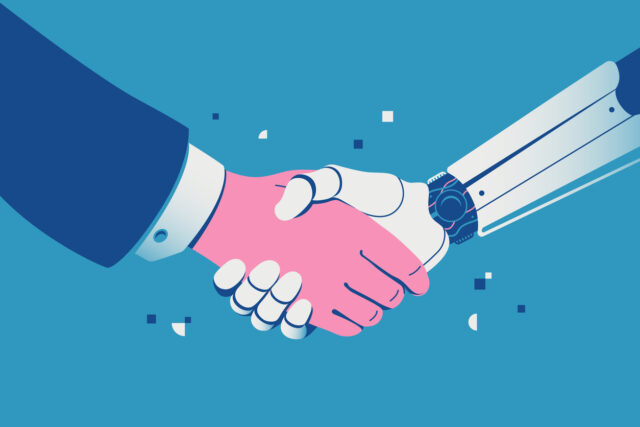The true possibilities of what can be achieved via AI is still being unearthed.
Indeed, the influence of new technology will only grow from here and new digital tools are being introduced all the time.
When it comes to generative AI, there is perhaps a misunderstanding that it is a new innovation. But the history of gen AI actually dates back to the 1960s. Among the first functioning examples was the ELIZA chatbot which was created in 1961 by British scientist Joseph Weizenbaum. It was the first talking computer program that could communicate with a human through natural language. It worked by recognising keywords in a user’s statement and then answering back through simple phrases or questions, in likeness to a conversation a human would have with a therapist. While ELIZA was seen as a parody and largely non-intelligent, its introduction has paved the way for later advancements in Natural Language Processing (NLP) and the future of generative AI.
Fast forward to today and the gen AI conversation and wider tech landscape looks very different. In late 2022, OpenAI launched ChatGPT – technology which has shaken the procurement function and beyond. ChatGPT interacts in a conversational way with its dialogue format making it possible for users to answer follow-up questions, admit mistakes, challenge incorrect answers and reject unsuitable requests. As such, the chatbot has created quite a buzz which has been felt across the globe.
Generative AI’s misconception
Speaking to us exclusively at DPW Amsterdam, Gregor Stühler, CEO at Scoutbee, believes there are some misconceptions around ChatGPT and the nature of how accurate the data it provides actually is. As is the case with any new technology, these things take time. “It’s always the same. It happened with electric cars, nobody thought that would solve the battery issue,” he discusses. “I think we are right at the peak of the hype cycle when it comes to those things and people have figured out what they can use it for. With wave one of gen AI, it is fine to have hallucinations of the model and if something is spat out that is not supported by the input.

“But by the second use case, hallucinations are not okay anymore because it’s working with accurate data and should not come up with some imaginary creative answers. It should be always supported by the data that is put in. This is very important that people understand that if you train the model and if you have the right setting, those hallucinations will go away and you can actually have a setting where the output of the model is 100% accurate.”
Data security
Michael van Keulen, Chief Procurement Officer at Coupa, agrees with Stühler and despite obvious benefits such as time and cost, he stresses caution should be used particularly when it comes to valuable tasks. “If you look at ChatGPT, it’s fine if you’re looking for recommendations for something low-risk. I need something for my wife’s birthday next week, you input three things that she loves and ask it to help. It’s great,” he tells us. “But it comes from data sources on the web that aren’t always governed, controlled or trustworthy. It’s whatever is out there. What about the algorithms that come with ChatGPT? I don’t know what’s influencing the search criteria. On Google, if you pay you are at the top of the search bar. But I don’t know what ChatGPT is governed by.”

Managing data leakage
Danny Thompson, Chief Product Officer at apexanalytix, explains that one of the biggest challenges with generative AI is being aware of a leakage of sensitive information combined with a contamination of important data. “We have a database of golden records for 90 million suppliers who are doing business with Fortune 500 companies and that is the best information we’ve been able to accumulate about the suppliers and their relationships as a supplier to large companies,” he tells us.

“We want to make sure we’re not loading sensitive information into a generative AI function that might allow just random people to access that data. Ultimately the customers in the space that we’re operating in are serious companies moving around large amounts of money and facing real risks that they have to manage. It’s really important that the data that they have is either highly accurate or at least they understand the degree to which it’s accurate. This means if you’re using the solution that you don’t understand the level of trust you can have in it, then you shouldn’t be using it yet.”
Can generative AI bridge the talent shortage?
Amid talent shortages in procurement, there are some sections of the procurement space questioning to whether AI and machine learning can plug the gap and reduce the necessity of recruitment. Naturally, this raises the debate of whether robots will replace humans. Stefan Dent, Co-Founder and Chief Strategy Officer at Simfoni, adds that while AI and machines won’t replace humans, it will mean people will need to find new forms of work and take on higher-value roles.

“The shape and structure of the modern procurement function will change quite dramatically and people will need to upskill,” he discusses. “A lot of the work will be taken over by the machine eventually either 20%, 50%, and then a hundred percent. But the human needs to have that in mind and then plan for that next three to five years. The procurement function of the future will be smaller, and they should purposely be doing that, to then look at solutions to find a way to enable it to happen naturally.
Future proof procurement
“For someone who’s joining procurement now, you’ve got this great opportunity to embrace digital. Young people can question ‘Well, why can’t it be done by a machine?’ They’re coming in with that mindset as opposed to fighting being replaced by a machine. I think for graduates coming into procurement, they’ve got the opportunity to play with digital and actually change the status quo.”
As we look to the future, gen AI and new forms of technology will continue to change the world and the way we work. In the short term, work is expected to continue to upgrade the user experience and workflows through gen AI in order to build greater trust for the end user. As transformation continues to happen, businesses and wider society must embrace new types of AI to thrive and stay ahead of the latest trends. The potential that gen AI tools possess is expected transform the workplace of tomorrow while delivering value-add such as time and cost savings on a day-to-day basis.
Given the speed of evolution and development, it is yet unimaginable exactly what form the digital landscape will take in years to come. However, that horizon brings with it fresh opportunity and excitement revolving around a whole new world of technology at our fingertips. The future is digital.











